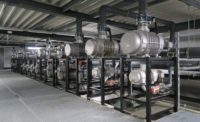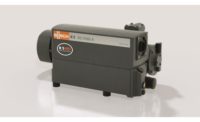Energy-efficient and reliable vacuum supply

Suttero Bazenheid is one of the most advanced meat processing companies in Switzerland. The business premises belong to Ernst Stutter AG, and meat from cows, calves and pigs is jointed here for further processing in other processing companies, or processed to form fresh meat products for wholesale and retail. The meat processing facility, which commenced operations in 2012, was built following the “Minergie” standard, meaning that it complies with strict regulations for sustainable construction. A photovoltaic system is installed on the roof to enable environmentally friendly energy generation, with the solar power being fed into the local public network. Energy for the entire Ernst Sutter AG company – and consequently the Suttero Bazenheid premises as well – is generated via hydropower. In addition, around 75% of the energy from refrigeration is also used to generate hot water. When creating vacuum for packaging, Suttero Bazenheid relies on a centralized vacuum system from Busch which is significantly more energy-efficient in operation than decentralized vacuum supplies on individual packaging machines. As a result, Ernst Sutter AG has created a production plant that corresponds to the latest standards, both from a technical and ecological perspective.
Ernst Sutter AG, with six production plants and two regional logistics platforms, is one of the most important Swiss companies in the meat processing and meat product production sector. It delivers to specialized butcher shops as well as retail and wholesale companies throughout Switzerland. In addition, various specialties such as “Bündnerfleisch” (an air-dried meat produced in the Grisons canton of Switzerland), “Bündner Rohschinken” (a raw ham product from the same area), and “Appenzeller Mostbröckli” (a cured, smoked and dried meat product from Appenzell), are exported to the EU and Far East.
It has a long tradition in this respect, dating back to the year 1909. Today, more than 1,000 employees work for Ernst Sutter AG. In setting up the Suttero Bazenheid meat processing facility, most fresh meat processing performed within the Ernst Sutter AG group of companies was concentrated at this location. The raw ingredients, mostly comprising sides of pork and beef, are predominantly procured from the nearby Bazenheid abattoir or Gossau. The pork and beef sides that are delivered are placed into cold rooms, separated by animal type. Using fully automatic process control, the individual sides in the cold rooms are collected, and automatically supplied to the respective jointing lines. Each workplace on the jointing lines is equipped with an advanced computer which shows the responsible employee which work steps need to be performed. These work steps are recorded electronically and allocated to the individual parts. This enables each portioned piece of meat to be allocated to a side of pork or beef, therefore ensuring the origin of the slaughtered animal and other information is traceable and/or accessible. Fresh meat products are packaged on a total of eight packaging lines, which are equipped with thermoforming or tray sealer packaging machines. Approximately two thirds of products are skin packaged while others, such as mincemeat, are packaged under a controlled atmosphere. The products are distributed under different names, some of which belong to the company itself, and some of which are external brands. Of the 300 employees at Bazenheid, around 180 work in the production department, in single-shift operation. Special shifts are only performed when necessary, during the summer fresh meat season.
Right from the planning phase, it was clear to Stefano Martinetti, Head of Area and Technology, that the vacuum required for packaging should be generated by a centralized vacuum system, as this represents the most energy-efficient type of vacuum generation. Fewer vacuum pumps are needed for a centralized vacuum supply than would be necessary for decentralized vacuum generation. In addition, two-stage evacuation made it possible to install rotary vane vacuum pumps with smaller pumping speeds, and therefore a smaller motor rating. The Busch centralized vacuum system supplies the tray sealer packaging machines with three independent ring lines. A rough vacuum of 50 millibar is constantly kept available in one of these. A vacuum accumulator guarantees that the required vacuum level is permanently and quickly available. In a second ring line, there is a medium vacuum of four millibar. If packages are evacuated, this initially only takes place up to the rough vacuum level. Once this is complete, a valve switches to “medium vacuum”, and final evacuation to four millibar of ultimate pressure is performed. This control means that the packaging chamber, and the packages, can be evacuated quickly and reliably before being closed, enabling very short cycles. A third independent ring line goes to the packaging lines with thermoforming packaging machines. It provides the forming stations in the packaging lines with what is referred to as a forming vacuum of 100 millibar, and that is used to pull the heated plastic film into shape.
The centralized vacuum system is controlled on a demand-driven basis in such a way that the required pressures are automatically kept available in all three ring lines. The only vacuum pumps in operation are the ones that are needed. As the maximum cycle time and greatest possible packaging volumes are not always used on all packaging machines, generally only some of the vacuum pumps will be in operation at any given time.
The centralized vacuum system achieves further energy savings through the omission of vacuum pumps in the packaging groups: the heat dissipation caused by the operation of the vacuum pumps, and the heated exhaust air, are not emitted directly into the packaging rooms. As a result, less power is needed for air-conditioning in these rooms – which also has a positive effect on energy consumption. As the centralized vacuum system is installed on an intermediate floor directly above the production and packaging rooms, its exhaust air is used to heat the intermediate floor during the winter months.
In addition to energy efficiency, the reliability of the vacuum supply is of course also a top priority. As Stefano Martinetti puts it: “Only a centralized vacuum system can guarantee a redundantly arranged and reliable vacuum supply for all eight packaging lines.” Busch AG is a partner and vacuum specialist, which planned and implemented the centralized vacuum system in such a way that it was custom-tailored to the technical conditions at Suttero Bazenheid. The system fundamentally consists of several vacuum modules for rough, medium and forming vacuums, and there is also a reserve unit. The reserve unit enables maintenance work to be performed during ongoing operation. Individual vacuum modules are released for maintenance in this process. To enable this to happen, the reserve module is automatically switched on.
This also has the advantage that no service personnel need to enter the hygiene-sensitive packaging and processing area for maintenance work.
The key components of this centralized vacuum system are the R 5 rotary vane vacuum pumps and Panda vacuum boosters. This combination means that the pumping speed and ultimate pressure of the system are significantly increased, meaning that lower energy consumption is required than when using larger vacuum pumps with comparable performance.
The demand-driven control is programmed in such a way that all vacuum pumps reach the same number of operating hours, even though generally not all vacuum pumps are operated at the same time. In contrast to the decentralized installation of vacuum pumps directly in the packaging machines, where they usually run through, this has the advantage that fewer operating hours are incurred overall for each vacuum pump. The result of this is that service intervals can be extended. Service intervals are organized in such a way that a visual check of oil levels is performed once a month, while an oil change and filter replacement are performed during an annual maintenance process.
Read more about Busch Pumps at www.buschusa.com.
Looking for a reprint of this article?
From high-res PDFs to custom plaques, order your copy today!





